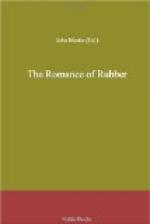How long the next five years must have seemed to the anxious Wickham, for it was that long before the first rubber tree flowered in the gardens at Heneratgoda, sixteen miles from Colombo, where the trees had finally been planted. In this year, 1881, experiments in tapping began, and it was plain that Wickham’s dream was to be realized.
From these few trees, so carefully tended in their youth, has sprung the whole rubber industry of Ceylon and the Far East. Wickham must indeed have been proud to see the plantations spreading from Ceylon to Malaya, where rubber was eagerly taken up by planters who were despairing of ever making a living out of coffee, and later to Sumatra and Java and Borneo. To-day rubber plantations cover an area of over 3,000,000 acres, with a yearly output of almost 360,000 tons, or about ten times the average yearly output of “wild rubber.”
There is a curious coincidence in the fact that Wickham got his idea about planting rubber trees in India at about the same time that men in America began to experiment with the horseless carriage. You may never have stopped to think of it, but mechanical experts say that without rubber pneumatic tires, automobiles could never have become the fine, swift vehicles they are. It was a wonderful thing that when in the early part of this century the automobile industry suddenly burst forth with a demand for rubber so great that Brazil could never have hoped to supply it, there was found ready in the Far East, as a result of the planting that had been done there, a supply that took care of the sudden emergency.
A little more than ten years ago American business men began to take an interest in the rubber plantations. They have shown characteristic energy in the field, and the greatest single rubber plantation in the world is owned by an American company, the United States Rubber Company. This plantation is on the island of Sumatra in the Dutch East Indies, one of the best governed colonies in the East. On this island is an orchard of rubber trees, as beautifully laid out and as well cared for as any orchard of fruit trees in our own country. For seventy square miles, an area as large as the District of Columbia, the orderly ranks of trees fill the gently rolling landscape, every inch of which is weeded as carefully as a garden. It takes twenty thousand employees to care for the trees, which number more than 5,000,000.
On this plantation the science of growing rubber trees has been brought to a perfection known nowhere else in the world. Groups of botanists, chemists and arboriculturists study constantly tree diseases, methods of increasing the yield, and the other problems of growing fine trees that will produce high grade rubber. Here, by experiment and inspection, the secrets of the rubber tree are being brought to light, so much so that growers look to this plantation for leadership in methods of rubber culture. This great project so far from American soil and in a field so new gives a thrill of pride to the Americans visiting Sumatra on their way around the world.




